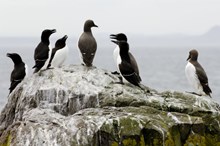18 May, 2016
Mixed fortunes for seabirds in East Caithness
A new report shows a mixed picture of population increases and declines for many seabirds in a protected natural area in East Caithness – though with some faring better than seabirds nationally.
The Scottish Natural Heritage (SNH) report on the East Caithness Cliffs Special Protection Area (SPA) found that there has been an increase in the numbers of razorbills, great black-backed gulls and European Shags since the previous count in 1999. It appears that 2015 was a good year for breeding seabirds and that this resulted in some particularly high counts.
Unfortunately, during the same period, a number of seabirds have declined, including northern fulmars, herring gulls, common guillemots and black-legged kittiwakes.
Nationally, after two decades of decreasing numbers, there are early signs of hope for some seabirds over the last two years; however, there are regional variations. At East Caithness Cliffs, the increases in numbers are generally larger and the decreases tend to be less than those recorded for some seabirds nationally.
Alex Robbins, SNH marine ornithologist, commented:
“This is good news for some seabirds in Caithness, and mirrors improved numbers that have been reported nationally for many seabirds earlier this year.
“We’re hopeful that the success of some seabirds mean their fortunes are looking up, but it’s really too early to say. There’s a lot of work going on to combat the pressures on seabirds – for example, controlling non-native predators. We are continuing to work with Scottish Government and others to safeguard these important seabird populations for which Scotland is renowned."
Scotland’s seabirds are of international importance. Their numbers may change due to a range of factors including food availability, weather, predation and pollution.
The overall numbers of seabirds are still much lower than a couple of decades ago. Some species continue to decline and are struggling in some areas, such as kittiwakes in the Northern Isles. Also affecting seabird populations are stormy winters, which can result in large ‘wrecks’ along the east coast of Scotland.
Seabirds at the East Caithness Cliffs SPA were last counted in 1999. There are approved plans for major offshore wind farm developments off the Caithness coast, and this seabird survey will ensure there is up-to-date information on the East Caithness seabird populations to help inform post consent monitoring.
To read the full report, Seabird Counts at East Caithness Cliffs SPA for Marine Renewable Casework, see http://bit.ly/1sBpJBP
For more on national seabird numbers, see the latest seabird indicator for Scotland published by SNH, using information collected from the Seabird Monitoring Programme at www.snh.gov.uk/docs/B424907.pdf
ENDS
Media queries
Contact SNH media officer, Vicki Mowat, on 0131 316 2659 or vicki.mowat@snh.gov.uk (Fri) or the SNH main press office on 01463 725 022.
Contact information
- Name
- SNH Media
- snhmedia@snh.gov.uk
NatureScot is Scotland's nature agency. We work to enhance our natural environment in Scotland and inspire everyone to care more about it. Our priority is a nature-rich future for Scotland and an effective response to the climate emergency. For more information, visit our website at www.nature.scot or follow us on X at https://x.com/NatureScot
’S e NatureScot buidheann nàdair na h-Alba. Bidh sinn a’ neartachadh àrainneachd na h-Alba agus a’ brosnachadh dhaoine gu barrachd suim a chur ann an nàdar. Tha e mar phrìomhachas againn gum bi nàdar na h-Alba beairteach agus gun dèilig sinn gu h-èifeachdach le èiginn na gnàth-shìde. Tha an tuilleadh fiosrachaidh aig www.nature.scot no air X aig https://x.com/NatureScot

